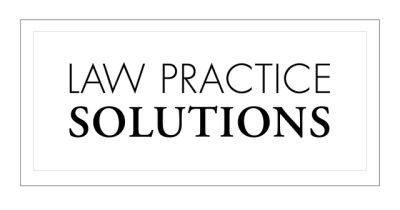
Law firms are not typically considered the epitome of efficiency. Even the most successful firms can struggle to fully leverage their resources for any number of valid reasons — the complex nature of legal work, time constraints, other priorities, and a lack of business-oriented training in law schools.
For many firms, pressing client needs and looming deadlines make finding the time and energy to implement new systems seem daunting. However, the time legal teams devote to activities that don’t make money infringes on time they could be practicing law. Not only does this cut into their billable time, but it can potentially diminish the quality of the service they deliver to clients.
Simply put, speed and efficiency are critical to success. Efficiency means eliminating wasted time, and there is no doubt that investing in the integration of technology can significantly enhance operational efficiency and team performance, which then allows practitioners to spend less time on non-billable tasks, focus on client matters, and deliver greater profits.
LEVERAGING TECH TOOLS
Advances in technology give law firms access to an array of communication, project management, and productivity tools that can enhance or, in some cases, replace their basic operating systems. For example, knowledge management has progressed well beyond standard tools like Outlook or Google Drive to include options similar to intranet sites that house updated, easily accessible information.
Practice management systems like Clio or MyCase, work management platforms such as Monday.com and Asana, and robust knowledge management systems play crucial roles in increasing efficiency and boosting productivity in the demanding legal environment.
ESTABLISHING INFORMATION PROTOCOLS
Law firms are inherently data heavy, which makes them susceptible to email overload. Countless hours are wasted managing emails. Establishing and implementing internal communication and information protocols is an essential first step in the process of developing greater efficiency. By defining where and how internal communication is managed and using specific tools for different types of information, firms can all but eliminate email as an internal communication platform and reserve it primarily for external use.
This approach aligns with the modern ethos of achieving a “zero inbox,” a concept well-articulated by Nick Sonnenberg in his book, “Come Up for Air.”1 It allows people to quickly and efficiently deal with every email that comes into their inbox, reduces the amount of time spent checking email, and ensures that nothing falls through the cracks.
ENHANCING INTERNAL COMMUNICATION
Developing clear communication protocols and showcasing strategies that blend visionary ideas with practical solutions can serve as a valuable guide for legal professionals. The key is having a clear use for each tool to ensure consistency and prevent information from being scattered across multiple platforms.
For example:
- Chat programs like Microsoft Teams, Google Chat, and Slack are excellent for quick queries not related to client matters and casual internal communication in a virtual environment.
- Client-matter information, updates, deadlines, and tasks should be communicated through features in your practice management system. If your current system doesn’t capture external emails or allow for internal notes, implementing a more integrated system can save time, reduce frustration, and enhance client service. Work management tools such as Monday.com, Airtable, and Asana are invaluable for handling the business side of a law firm.
The focus should be on optimizing company processes based on the ease and speed of retrieving information, not on the ease of transferring or storing information. In other words, everyone should be able to find what they’re looking for — not just the person who stored it.
IDENTIFYING PAIN POINTS
While opportunities for automation and streamlining are always emerging, the complexity of those options can be overwhelming. The lack of unbiased information and the desire for perfect implementation creates a challenge.
To start, law firms should identify pain points such as missed deadlines, information overload, and the frustrating digital scavenger hunt for documents. Understanding your challenges can guide the selection and implementation of technological solutions. Implementing a framework like Sonnenberg’s Communication, Planning, and Resources (CPR) model,2 for example, allows firms to identify and separate the different types of communication (internal, external, and personal) and tailor its tools to each type and the unique needs of the practice.
Keep in mind that effective use of technology hinges on well-designed standard operating procedures, thorough training, and adherence to processes.
ADDRESSING SYSTEMIC INEFFICIENCIES
Rather than simply managing work pressures, firms need to dedicate considerable time, attention, and resources to resolving systemic operational issues. This is especially crucial for growth-minded firms. Expanding your team before a solid framework for operational efficiency is in place is likely to amplify problematic processes. To prevent scaling issues, it is imperative to address systemic inefficiencies with the necessary upgrades in place before hiring more people or developing new business.
CONCLUSION
Ultimately, law firm inefficiency can hurt client satisfaction and potentially lead to a loss of business. Regardless of time and resources, law firms must prioritize technology to streamline operations, enhance efficiency, and maintain a competitive edge.
Heinan Landa, author of “The Modern Law Firm,”3 poses a compelling question: “What does a thriving law firm look like in five years?”
In a word: Different.